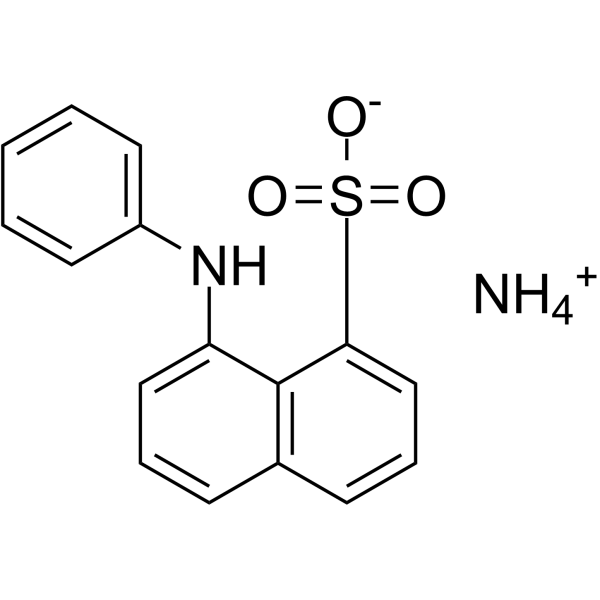1-ANILINONAPHTHALENE-8-SULFONIC ACID AMMONIUM SALT

1-ANILINONAPHTHALENE-8-SULFONIC ACID AMMONIUM SALT structure
|
Common Name | 1-ANILINONAPHTHALENE-8-SULFONIC ACID AMMONIUM SALT | ||
|---|---|---|---|---|
| CAS Number | 28836-03-5 | Molecular Weight | 316.37500 | |
| Density | N/A | Boiling Point | 582.9ºC at 760mmHg | |
| Molecular Formula | C16H16N2O3S | Melting Point | 242-244 °C(lit.) | |
| MSDS | USA | Flash Point | 306.3ºC | |
|
Effects of isorhamnetin on tyrosinase: inhibition kinetics and computational simulation.
Biosci. Biotechnol. Biochem. 76(6) , 1091-7, (2012) We studied the inhibitory effects of isorhamnetin on mushroom tyrosinase by inhibition kinetics and computational simulation. Isorhamnetin reversibly inhibited tyrosinase in a mixed-type manner at Ki=0.235±0.013 mM. Measurements of intrinsic and 1-anilinonaph... |
|
|
pH-Induced molten globule state of Rhizopus niveus lipase is more resistant against thermal and chemical denaturation than its native state.
Cell Biochem. Biophys. 62(3) , 487-99, (2012) Here, we have characterized four pH-dependent states: alkaline state, "B" (pH 9.0), native state, "N" (pH 7.4), acid-induced state, "A" (pH 2.2) and molten globule state, "MG" (pH 1.8) of Rhizopus niveus lipase (RNL) by CD, tryptophanyl fluorescence, ANS bind... |
|
|
pH-dependent conformational transitions in conalbumin (ovotransferrin), a metalloproteinase from hen egg white.
Cell Biochem. Biophys. 61 , 551-560, (2011) Acid unfolding pathway of conalbumin (CA), a monomeric glycoprotein from hen egg white, has been investigated using far- and near-UV CD spectroscopy, intrinsic fluorescence emission, extrinsic fluorescence probe 1-anilino-8-napthalene sulfonate (ANS) and dyna... |
|
|
Structural and functional interaction of fatty acids with human liver fatty acid-binding protein (L-FABP) T94A variant.
FEBS J. 281(9) , 2266-83, (2014) The human liver fatty acid-binding protein (L-FABP) T94A variant, the most common in the FABP family, has been associated with elevated liver triglyceride levels. How this amino acid substitution elicits these effects is not known. This issue was addressed us... |
|
|
Detection and analysis of protofibrils and fibrils of hemoglobin: implications for the pathogenesis and cure of heme loss related maladies.
Arch. Biochem. Biophys. 533(1-2) , 69-78, (2013) TFE induces structural alterations of proteins similar to the lipid environment of biological membranes, implicating these studies worthy of analyzing protein conformation in membranes such as red blood cells (RBCs). Heme loss occurs on rupturing of RBCs as f... |
|
|
Biophysical analysis of apolipoprotein E3 variants linked with development of type III hyperlipoproteinemia.
PLoS ONE 6(11) , e27037, (2011) Apolipoprotein E (apoE) is a major protein of the lipoprotein transport system that plays important roles in lipid homeostasis and protection from atherosclerosis. ApoE is characterized by structural plasticity and thermodynamic instability and can undergo si... |
|
|
High-pressure SANS and fluorescence unfolding study of calmodulin.
Biochim. Biophys. Acta 1844(9) , 1560-8, (2014) Apo-calmodulin, a small soluble mainly α protein, is a calcium-dependent protein activator. Calcium binding affects the calmodulin conformation but also its stability. Calcium free form unfolds between 40 and 80°C, whereas the calcium-saturated form is stable... |
|
|
Application of ANS fluorescent probes to identify hydrophobic sites on the surface of DREAM.
Biochim. Biophys. Acta 1844(9) , 1472-80, (2014) DREAM (calsenilin or KChIP-3) is a calcium sensor involved in regulation of diverse physiological processes by interactions with multiple intracellular partners including DNA, Kv4 channels, and presenilin, however the detailed mechanism of the recognition of ... |
|
|
Hydrogen peroxide targets the cysteine at the active site and irreversibly inactivates creatine kinase.
Int. J. Biol. Macromol. 49(5) , 910-6, (2011) In our study, we showed that at a relatively low concentration, H(2)O(2) can irreversibly inactivate the human brain type of creatine kinase (HBCK) and that HBCK is inactivated in an H(2)O(2) concentration-dependent manner. HBCK is completely inactivated when... |
|
|
Altering APP proteolysis: increasing sAPPalpha production by targeting dimerization of the APP ectodomain.
PLoS ONE 7(6) , e40027, (2012) One of the events associated with Alzheimer's disease is the dysregulation of α- versus β-cleavage of the amyloid precursor protein (APP). The product of α-cleavage (sAPPα) has neuroprotective properties, while Aβ1-42 peptide, a product of β-cleavage, is neur... |